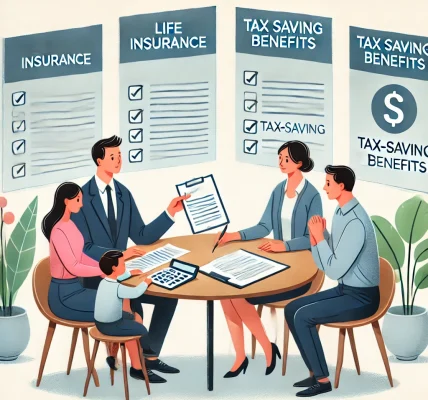Introduction
Debt can be overwhelming, whether it’s a mortgage, student loans, credit card debt, or personal loans. Many people struggle to find a secure way to pay off their financial obligations without sacrificing their long-term financial goals. Life insurance can be a powerful tool to help manage and eliminate debt, ensuring financial stability for both you and your loved ones.
In this guide, we’ll explore how life insurance can be used to pay off debt and loans, the different types of policies that can help, and DIY strategies to maximize your financial security.
1. Understanding the Connection Between Life Insurance and Debt
Life insurance is primarily designed to provide financial protection to beneficiaries in the event of the policyholder’s passing. However, it can also serve as a strategic tool to help manage and eliminate debts effectively.
There are two main ways life insurance helps with debt:
- Debt Repayment After Death: The policy’s death benefit ensures that loved ones are not burdened with unpaid debts.
- Using Cash Value During Your Lifetime: Permanent life insurance policies accumulate cash value that can be accessed to pay off existing debts.
By understanding these mechanisms, you can create a financial plan that safeguards your wealth while reducing your liabilities.
2. Types of Life Insurance That Help with Debt Repayment
2.1 Term Life Insurance for Debt Protection
Best for: Ensuring your family can pay off debts if you pass away unexpectedly.
- Provides a lump sum death benefit to beneficiaries.
- Affordable premiums with coverage for a fixed period (10, 20, or 30 years).
- Ideal for mortgage protection or covering personal loans.
2.2 Whole Life Insurance for Debt Management
Best for: Long-term financial planning and debt repayment.
- Covers you for your entire lifetime.
- Accumulates cash value, which can be borrowed against for debt repayment.
- Higher premiums but provides lifelong security.
2.3 Universal Life Insurance for Flexibility
Best for: Those who want flexible payments and cash value growth.
- Allows adjustable premium payments based on financial needs.
- Builds cash value over time, which can be accessed for emergencies.
- Can be structured to provide a growing death benefit to cover increasing debts.
3. DIY Strategies to Use Life Insurance for Debt Payoff
Step 1: Calculate Your Total Debt
Before choosing a life insurance plan, list all your debts, including:
- Mortgage loans
- Credit card balances
- Auto loans
- Student loans
- Medical bills
Use a debt calculator to determine how much coverage you need.
Step 2: Choose the Right Policy
- For short-term debt (like car loans and credit cards): Term life insurance is cost-effective.
- For long-term debt (like mortgages and business loans): Whole or universal life insurance offers more flexibility.
Step 3: Name Beneficiaries Strategically
- If your goal is debt repayment, ensure your beneficiaries understand how to use the payout.
- Consider setting up a trust to manage the funds responsibly.
Step 4: Use the Cash Value Option
If you have a whole or universal life insurance policy, you can:
- Withdraw cash to pay off debt (subject to policy terms).
- Borrow against the policy at lower interest rates compared to personal loans.
- Use dividends (from participating policies) to pay down liabilities.
Step 5: Avoid Common Pitfalls
- Don’t borrow too much: Excessive withdrawals can reduce your death benefit.
- Ensure premiums remain affordable: Missing payments can lead to policy lapses.
- Review your policy regularly: Adjust your coverage based on changing debt levels.
4. Real-Life Examples of Life Insurance for Debt Management
Example 1: Paying Off a Mortgage with Term Life Insurance
John, a 40-year-old homeowner, takes out a 30-year term life insurance policy equal to his mortgage balance. If John passes away, his family receives a death benefit that pays off the remaining mortgage, securing their home.
Example 2: Using Whole Life Insurance for Business Loans
Maria, a small business owner, has a whole life insurance policy. Over time, she builds cash value, allowing her to borrow against it to pay off a business loan without high-interest rates from banks.
Example 3: Reducing Credit Card Debt with Policy Loans
David, who has accumulated credit card debt, uses his universal life policy’s cash value to pay off high-interest balances, reducing financial stress.
5. Myths About Using Life Insurance for Debt
Myth #1: Life Insurance is Only for Death Benefits
Reality: Many policies offer cash value and loan options to help with financial needs during your lifetime.
Myth #2: It’s Too Expensive to Use for Debt Repayment
Reality: Term life insurance is highly affordable, and permanent policies provide long-term financial advantages.
Myth #3: Only Wealthy People Use Life Insurance for Debt Management
Reality: Anyone with debts can benefit from strategic life insurance planning.
Conclusion
Life insurance is more than just a safety net—it can be a powerful financial tool to eliminate debt and achieve financial freedom. By selecting the right policy, leveraging its benefits, and planning strategically, you can protect yourself and your loved ones from financial burdens.
Ready to take control of your financial future? Start by assessing your debt, choosing the right policy, and making a plan to secure a debt-free life!
Call to Action
✅ Review your current debts
✅ Compare different life insurance policies
✅ Use life insurance strategically to pay off loans




